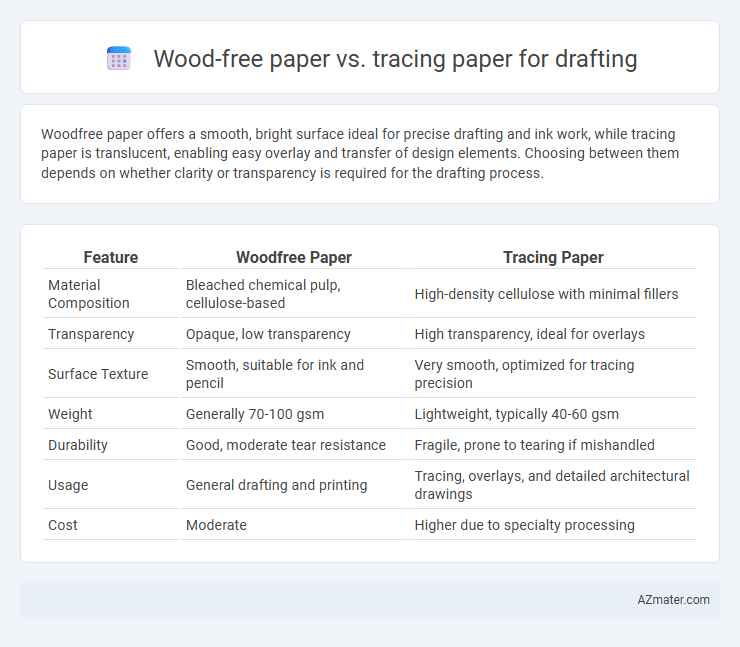Woodfree paper offers a smooth, bright surface ideal for precise drafting and ink work, while tracing paper is translucent, enabling easy overlay and transfer of design elements. Choosing between them depends on whether clarity or transparency is required for the drafting process.
Table of Comparison
| Feature | Woodfree Paper | Tracing Paper |
|---|---|---|
| Material Composition | Bleached chemical pulp, cellulose-based | High-density cellulose with minimal fillers |
| Transparency | Opaque, low transparency | High transparency, ideal for overlays |
| Surface Texture | Smooth, suitable for ink and pencil | Very smooth, optimized for tracing precision |
| Weight | Generally 70-100 gsm | Lightweight, typically 40-60 gsm |
| Durability | Good, moderate tear resistance | Fragile, prone to tearing if mishandled |
| Usage | General drafting and printing | Tracing, overlays, and detailed architectural drawings |
| Cost | Moderate | Higher due to specialty processing |
Introduction to Drafting Papers
Drafting papers such as woodfree paper and tracing paper serve distinct purposes in technical drawing and design projects. Woodfree paper, made from chemical pulp and free of mechanical wood pulp, offers a smooth surface with high opacity ideal for precise line work and long-term durability. Tracing paper, characterized by its translucent quality, enables the easy transfer and overlay of design elements, making it essential for iterative revisions and layering in drafting processes.
What is Woodfree Paper?
Woodfree paper is a high-quality paper made from chemical pulp, free from lignin, ensuring durability and minimal yellowing over time, which makes it ideal for drafting applications requiring clarity and longevity. It offers a smooth surface with excellent opacity and strength, providing crisp, clear lines essential for precise technical drawings. Unlike tracing paper, which is translucent and primarily used for overlays, woodfree paper supports detailed sketches and final drafts with a clean, professional finish.
What is Tracing Paper?
Tracing paper is a translucent, lightweight paper specifically designed for drafting and technical drawing, allowing designers to accurately copy or overlay images and designs. Unlike woodfree paper, which is opaque and made from chemical pulp without mechanical wood fibers to ensure smoothness and brightness, tracing paper is treated to achieve high transparency and durability. Its unique cellulose fiber structure enables clear visibility of underlying layers, making it essential for precision work in architecture, engineering, and art.
Physical Properties Comparison
Woodfree paper, characterized by its high opacity and smooth surface, offers excellent durability and resistance to yellowing, making it ideal for long-lasting drafting documents. Tracing paper, with its translucent quality and lighter weight, enables easy overlaying for precise revisions but tends to be less durable and more susceptible to tearing. Both papers differ in thickness, opacity, and texture, directly influencing their suitability for various drafting applications requiring either permanence or flexibility.
Transparency and Visual Clarity
Woodfree paper offers moderate transparency with a smooth surface ideal for clear text and image reproduction, but it lacks the high translucency required for precise overlay work. Tracing paper excels in transparency, providing superior visual clarity for detailed drafting and layering due to its almost translucent quality that allows underlying lines to be easily seen. The choice between woodfree and tracing paper hinges on the needed level of transparency and sharpness for accurate visual alignment in drafting projects.
Durability and Erasability
Woodfree paper offers superior durability due to its high-quality, lignin-free fibers that resist yellowing and tearing, making it ideal for long-term drafting projects. Tracing paper, composed of translucent materials like cotton or polyester, allows ease of light transmission but tends to be more fragile and less resistant to repeated erasing, often resulting in surface wear. For durability and erasability in drafting, woodfree paper outperforms tracing paper by maintaining integrity under frequent handling and multiple erasures.
Ink and Pencil Compatibility
Woodfree paper offers superior ink absorption and prevents smudging, making it ideal for drafting with technical pens and fine-tip markers. Tracing paper, with its smooth, translucent surface, excels in pencil work, allowing easy erasure and clean lines but tends to cause ink to pool or smear. For mixed media drafting, woodfree paper ensures crisp ink lines, while tracing paper provides excellent pencil compatibility.
Cost Analysis: Woodfree vs Tracing Paper
Woodfree paper generally costs less than tracing paper, making it a budget-friendly option for large-volume drafting projects. Tracing paper, valued for its translucency and precision in overlay work, tends to be pricier due to specialized manufacturing processes. Organizations often balance cost against functional need, choosing woodfree paper for routine drafts and tracing paper when clarity and detail in overlays are essential.
Environmental Impact Considerations
Woodfree paper, made from chemical pulp with fewer lignins, offers higher durability and recyclability compared to tracing paper, which is often made from cellulose or synthetic fibers with lower biodegradability. Tracing paper's production can involve more energy-intensive processes and chemical treatments, resulting in a larger carbon footprint and potential environmental pollutants. Choosing woodfree paper supports sustainable forestry practices and has a reduced ecological impact due to better recyclability and biodegradability in drafting applications.
Choosing the Best Paper for Drafting Needs
Woodfree paper offers a smooth, high-quality surface ideal for precise ink and pencil work, ensuring clarity and durability in drafting projects. Tracing paper provides translucency that allows easy overlaying and corrections, making it essential for iterative design processes and detailed revisions. Selecting the best paper depends on whether the priority is permanence and print quality (woodfree) or flexibility and transparency (tracing).

Infographic: Woodfree paper vs Tracing paper for Drafting
 azmater.com
azmater.com